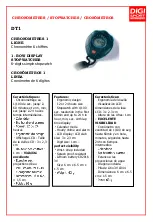
Getting Started
23
•
Use the HR feature only for measuring your heart rate. The accuracy of the optical
heart rate sensor may be diminished depending on measurement conditions and
surroundings.
•
Cold ambient temperatures may affect your measurement; during winter or cold
weather, keep yourself warm when checking your heart rate.
•
Smoking or consuming alcohol before taking measurements may cause your heart
rate to be different from your normal heart rate.
•
Do not move, talk, yawn, or breathe deeply while taking heart rate measurements.
Doing so may cause your heart rate to be recorded inaccurately.
•
If your heart rate is extremely high or low, measurements may be inaccurate.
•
If measuring children’s heart rates, the measurement may not accurate.
•
Users with thin wrists may receive inaccurate heart rate measurements when the
device is loose, causing the light to be reflected unevenly. In this case, wear the
Watch around your lower arm above the wrist.
•
If heart rate measurement is not working properly, adjust the position of the device’s
optical heart rate sensor to the right, left, up, or down on your wrist, or wear the
device on your inner arm so that the sensor is in contact with your skin.
•
If the optical heart rate sensor and the electrical biosensors are dirty, wipe the
sensor and try again. If foreign materials prevent the light from reflecting evenly, the
measurement may not accurate.
•
The signal may be affected by your skin brightness, blood flow under your skin, and
the cleanliness of the sensor area.
•
For accurate measurements, use the Ridge sport band. The Ridge sport band may be
sold separately depending on the model.
















































